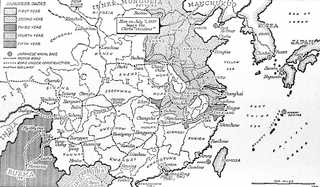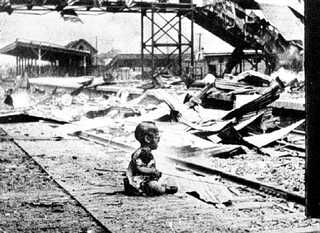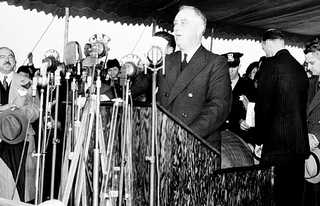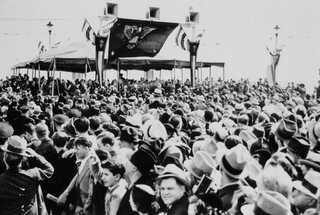China Incident 1937
|
China map - bg
|
|
"Soochow Medal" from Fourth Marines in China 1927-1941
|
|
Shanghai baby, still frame from 9/15/37 newsreel
|
|
Quarantine speech outdoors in Chicago 10/05/37, photo from FDRL
|
|
Quarantine speech outdoors in Chicago 10/05/37, photo from FDRL - cu
|
Japan had become more militant, refused international solution to China problem
- Feb, 26, 1936 - most ambitious coup attempt of decade
- young army radicals wanted faster expansion - Army put down revolt
- Control Group - discipline, order, conquer China but no revolts
- Richard Sorge was spy in Japan for Russians
- Stalin sought strong China to contain Japan
Sept. 1935 - Fred. Leith-Ross mission
- tried to get Japan to coop with Britain in granting loan to China
- Japan refused - British went ahead - tied new Chinese currency to the pound
- solved problems caused by U.S. silver purchases since 1934
- Chinese economy recovered - also end of civil war
Dec. 12, 1936 - Sian incident - Chiang kidnapped by Manchurian warlord Yang
- Yang had joined communist effort to unite China ag. Japan
- Mao recently completed Long March to SE China
- Mao pro-Popular Front - Stalin had recognized Chiang's Nanking govt
July 5, 1937 - 2 days before Marco Polo bridge incident - formal KMT-CCP agreement
- Chiang ended anticommunist war, was released, merged 2 armies in 1937
- China showed success of Comintern's Popular Front
July 7 - incident at the Marco Polo bridge
- Chinese fired on Japanese troops in Peking (prob. Mao's plot)
- Prince Konoe new PM - allowed army to punish China
- July 27 proclaimed "new order" in Asia - total war
July 16 - Hull's declaration for "peaceful solution" - 60 nations
- FDR sent 1200 marines to Shanghai, but refused more Navy ships
- Fourth Marines in China 1927-1941 by Ron Moss
July 17 - 10 days after Marco Polo bridge incident, Chiang sent troops to north
- Chinese advanced into former demilitarized areas according to Tangku truce with Japan, but truce now dead
- Chiang called on Chinese people to resist Japan
- Chiang encouraged by German advisor Gen. Alex. von Falkenhausen who told Chiang that China could drive Japan "over the Great Wall"
- Chiang miscalculated: Japan would fight, West would not help China
July 28 - Japan bombers struck 3 cities
Aug. 13 - terror bombing of Shanghai - beg. of continual Sino-Japan War, but called only "Incident"
Aug. 17 - FDR didnot invoke Neutrality Act but said it was on "a 24-hour basis" until a formal declaration of war or a real threat to the U.S.
Aug. 29 - U.S. freighter Wichita sailed from Baltimore with 19 planes for China, but Aug. 25 Japan declared blockade of China coast.
Sept. 13 - Maritime Commission chairman Joseph Kennedy ordered American Pioneer Line to detain Wichita in San Pedro CA - unloaded planes and continued on to Hong Kong
Sept. 14 - FDR declared no government-owned ship to carry arms to China or Japan
Sept. 20 - DuPont Co. agreed not to sell arms to China or Japan, but U.S. exports to China and Japan continued, especially through England. Joseph Green, head of National Munitions Control Board, said later that he would issue export licenses for aircraft to nations that bomb civilians only "with great regret" - private aircraft industry complied and stopped aircraft exports to Japan, although total 1938 exports to Japan was $9,092,999.
Oct. 5 - FDR's Quarantine speech in Chicago
- "When an epidemic of physical disease starts to spread, the community approves and joins in a quarantine of the patients in order to protect the health of the community against the spread of the disease"
- FDR seeking new solution, but unsure of specific method
- after, sought joint action with England, but rejected by Chamberlain 1/13/38
Oct. 6 - League called for 9-Power conference in Brussels
- U.S. attended but FDR vetoed proposal for economic sanctions
- Nov. 24 - conference ended in failure



